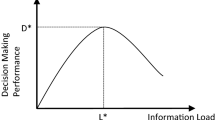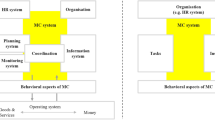Abstract
The establishment of the interoperability of accounting and other IS with those of business partners is regarded as a primary source of efficiency gains and innovation for organizations in today’s networked economy. Thus, inter-organizational information systems (IOIS) play a critical role in present day organizations and their relationships with business partners. Nevertheless, potential benefits that can be achieved from an IOIS implementation are tightly connected to the achievement of a critical number of adopters among business partners. One primary strategy introduced in this context is the exertion of coercive pressure to persuade business partners to adopt. However, results of prior investigations on the influence of coercive pressure on organizational adoption decisions have varied, while experimental investigations of coercive pressure as a strategy to foster adoption of IOIS among business partners have remained scarce. This study conducts a controlled field experiment on organizational level to investigate the effect of applied coercive pressure on the adoption of IOIS among 126 business partners of a medium-sized firm in Germany. Results present empirical evidence for a positive effect of coercive pressure. Assuming a configurational perspective, several organizational characteristics are further hypothesized to moderate this relationship. The type of industry and the degree of technology readiness are found to be significant moderators. The results emphasize the importance of a configurational perspective in investigations on the organizational level, and provide decision-makers with valuable insights into the mechanisms that drive the effect of coercive pressure as a strategy to foster adoption of IOIS among business partners.


Similar content being viewed by others
References
Au YA, Kauffman RJ (2001) Should we wait? Network externalities, compatibility, and electronic billing adoption. J Manag Inf Syst 18:47–63
Bala H, Venkatesh V (2007) Assimilation of interorganizational business process standards. Inf Syst Res 18:340–362
Bandiera O, Barankay I, Rasul I (2011) Field experiments with firms. J Econ Perspect 25:63–82
Bapna R, Goes P, Wei Kwok Kee, Zhang Zhongju (2011) A finite mixture logit model to segment and predict electronic payments system adoption. Inf Syst Res 22:118–133
Chatterjee D, Grewal R, Sambamurthy V (2002) Shaping up for E-Commerce: institutional Enablers of the Organizational Assimilation of Web Technologies. Management Information Systems Quarterly 26:65–89
Chau PYK, Hui KL (2001) Determinants of small business EDI adoption: an empirical investigation. J Organ Comput Electron Commer 11:229–252
Chwelos P, Benbasat I, Dexter AS (2001) Research report: empirical Test of an EDI adoption model. Inf Syst Res 12:304–321
Cohen J, Cohen P, West SG (2002) Applied multiple regression/correlation analysis for the behavioral sciences, 3rd edn. Taylor & Francis Ltd., Mahwah
Cramér H (1946) Mathematical Methods of Statistics. Princeton University Press, Princeton
Damanpour F (1992) Organizational size and innovation. Organ Stud 13:375–402
Demirkan H, Bess C, Spohrer J, Rayes A, Allen D (2015) Innovations with smart service systems: analytics, big data, cognitive assistance, and the internet of everything. Commun Assoc Inf Syst 37:733–752
DiMaggio PJ, Powell WW (1983) The iron cage revisited: institutional isomorphism and collective rationality in organizational fields. Am Soc Rev 48:147–160
European Commission (2005) The new SME definition—user guide and model declaration. European Commission, Brussels
Fichman RG (2004) Going beyond the dominant paradigm for information technology innovation research: emerging concepts and methods. J Assoc Inf Syst 5:314–355
Field AP, Hole G (2003) How to design and report experiments. Sage Publications, London
Fisher RA (1925) Statistical methods for research workers. Cosmo Publications, New Delhi
Fiss PC (2007) A set-theoretic approach to organizational configurations. Acad Manag Rev 32:1180–1198
Fiss PC, Marx A, Cambré B (2013) Configurational theory and methods in organizational research: introduction. In: Fiss PC, Cambré B, Marx A (eds) Configurational theory and methods in organizational research. Emerald Group Publishing Limited, Bradford, pp 1–22
Grant AM, Wall TD (2008) The neglected science and art of quasi-experimentation: why-to, when-to, and how-to advice for organizational researchers. Organ Res Methods 12:653–686
Harrison GW, List JA (2004) Field experiments. J Econ Lit 42:1009–1055
Hart P, Saunders C (1997) Power and trust: critical factors in the adoption and use of electronic data interchange. Organ Sci 8:23–42
Hart PJ, Saunders CS (1998) Emerging electronic partnerships: antecedents and dimensions of EDI Use from the supplier’s perspective. J Manag Inf Syst 14:87–111
Hong W, Zhu K (2006) Migrating to internet-based E-commerce: factors affecting E-commerce adoption and migration at the firm level. Inf Manag 43:204–221
Howard M, Vidgen R, Powell P (2006) Automotive E-hubs: exploring motivations and barriers to collaboration and interaction. J Strateg Inf Syst 15:51–75
Iacovou CL, Benbasat I, Dexter AS (1995) Electronic data interchange and small organizations: adoption and impact of technology. Manag Inf Syst Q 19:465–485
Iskandar BY, Kurokawa S, LeBlanc LJ (2001) Adoption of electronic data interchange: the role of buyer–supplier relationships. IEEE Trans Eng Manag 48:505–517
Jackson M, Cox DR (2013) The principles of experimental design and their application in sociology. Annu Rev Soc 39:27–49
Jeyaraj A, Rottman JW, Lacity MC (2006) A review of the predictors, linkages, and biases in IT innovation adoption research. J Inf Technol 21:1–23
Katz ML, Shapiro C (1986) Technology adoption in the presence of network externalities. J Polit Econ 94:822–841
Kauffman RJ, Mohtadi H (2004) Proprietary and open systems adoption in E-procurement: a risk-augmented transaction cost perspective. J Manag Inf Syst 21:137–166
Kim B, Barua A, Whinston AB (2002) Virtual field experiments for a digital economy: a nnew research methodology for exploring an information economy. Decis Support Syst 32:215–231
Koch B (2014) E-invoicing/E-billing—key stakeholders as game changers. Billentis, Wil
Kreuzer S, Eckhardt A, Bernius S, Krönung J (2013) A unified view of electronic invoicing adoption: developing a meta-model on the governmental level. In: HICSS 2013 proceedings, Maui
Kreuzer S, Krönung J, Bernius S (2014) Dismantling the environmental context—the role of environmental characteristics in the organizational adoption of open standard-based inter-organizational information systems. In: ECIS 2014 proceedings, Tel Aviv
Kuehne K, Kosch L, Cuylen A (2015) Will XML-based electronic invoice standards succeed? An explorative study. In: ECIS 2015 proceedings, Münster
Lempinen H, Penttinen E (2009) Assessing the business value of electronic order-to-payment cycle. In: ECIS 2009 proceedings, Verona
Liebowitz SJ, Margolis SE (1994) Network externality: an uncommon tragedy. J Econ Perspect 8:133–150
Loukis E, Charalabidis Y (2012) Business value of information systems interoperability—a balanced scorecard approach. In: ECIS 2012 proceedings, Barcelona
Lyytinen K, Damsgaard J (2011) Inter-organizational information systems adoption—a configuration analysis approach. Eur J Inf Syst 20:496–509
Markus ML, Loebbecke C (2013) Commoditized digital processes and business community platforms: new opportunities and challenges for digital business strategies. Manag Inf Syst Q 37:649–654
Martin SL, Liao H, Campbell EM (2013) Directive versus empowering leadership: a field experiment comparing impacts on task proficiency and proactivity. Acad Manag J 56:1372–1395
McElheran K (2015) Do market leaders lead in business process innovation? The case(s) of E-business adoption. Manag Sci 61:1197–1216
Meyer AD, Tsui AS, Hinings CR (1993) Configurational approaches to organizational analysis. Acad Manag J 36:1175–1195
Miller D (1984) Organizations: a quantum view. Prentice-Hall, New Jersey
Miller D (1986) Configurations of strategy and structure: towards a synthesis. Strateg Manag J 7:233–249
Miller D (1987) The genesis of configuration. Acad Manag Rev 12:686–701
Penttinen E, Tuunainen VK (2010) Assessing the effect of external pressure in inter-organizational IS adoption—case electronic invoicing. In: Sharman R, Rao HR, Raghu TS (eds) Exploring the grand challenges for next generation E-business. Springer, Berlin, pp 269–278
Pfeffer J, Salancik GR (1978) The external control of organizations: a resource dependence perspective. Harper & Row, New York
Premkumar G, Ramamurthy K (1995) The role of interorganizational and organizational factors on the decision mode for adoption of interorganizational systems. Decis Sci 26:303–336
Provan KG, Beyer JM, Kruytbosch C (1980) Environmental linkages and power in resource-dependence relations between organizations. Adm Sci Q 25:200–225
Ragin CC (2013) Foreword: the distinctiveness of configurational research. In: Fiss PC, Cambré B, Marx A (eds) Configurational theory and methods in organizational research. Emerald Group Publishing Limited, Bradford, pp xv–xx
Rai A, Patnayakuni R, Seth N (2006) Firm performance impacts of digitally enabled supply chain integration capabilities. MIS Q 30:225–246
Raymond L, Bergeron F (1996) EDI success in small and medium-sized enterprises: a field study. J Organ Comput Electron Commer 6:161–172
Reimers K, Johnston RB, Klein S (2013) An empirical evaluation of existing IS change theories for the case of IOIS evolution. Eur J Inf Syst 23:373–399
Riggins FJ, Mukhopadhyay T, Kriebel CH (1995) Optimal policies for subsidizing supplier interorganizational system adoption. J Organ Comput 5:295–325
Robey D, Im G, Wareham J (2008) Theoretical foundations of empirical research on interorganizational systems: assessing past contributions and guiding future directions. J Assoc Inf Syst 9:497–518
Shapiro C, Varian H (1998) Information rules: a strategic guide to the network economy. Harvard Business Review Press, Watertown
Sila I (2010) Do organisational and environmental factors moderate the effects of internet-based interorganisational systems on firm performance? Eur J Inf Syst 19:581–600
Son J-Y, Benbasat I (2007) Organizational buyers’ adoption and use of B2B electronic marketplaces: efficiency- and legitimacy-oriented perspectives. J Manag Inf Syst 24:55–99
Son J-Y, Narasimhan S, Riggins FJ (2005) Effects of relational factors and channel climate on EDI usage in the customer–supplier relationship. J Manag Inf Syst 22:321–353
Son J-Y, Narasimhan S, Riggins FJ, Kim N (2008) Understanding the development of IOS-based trading partner relationships: a structural model with empirical validation. J Organ Comput Electron Commer 18:34–60
Spann M, Hinz O, Hann I-H, Skiera B (2010) Decision making in virtual worlds: an experimental test of altruism, fairness and presence. In: ECIS 2010 proceedings, Pretoria
Sutanto J, Palme E, Tan C-H, Phang CW (2013) Addressing the personalization-privacy paradox: an empirical assessment from a field experiment on smartphone users. Manag Inf Syst Q 37:1141–1164
Teo HH, Wei KK, Benbasat I (2003) Predicting intention to adopt interorganizational linkages: an institutional perspective. Manag Inf Syst Q 27:19–49
Teo TSH, Ranganathan C, Dhaliwal J (2006) Key dimensions of inhibitors for the deployment of web-based business-to-business electronic commerce. IEEE Trans Eng Manag 53:395–411
Thong JYL (1999) An integrated model of information systems adoption in small businesses. J Manag Inf Syst 15:187–214
Thong JY, Yap C-S (1995) CEO characteristics, organizational characteristics and information technology adoption in small businesses. Omega 23:429–442
Thong JYL, Yap C-S, Raman KS (1996) Top management support, external expertise and information systems implementation in small businesses. Inf Syst Res 7:248–267
Tornatzky LG, Fleischer M (1990) The processes of technological innovation. Lexington Books, Lexington
Tsai M-C, Lai K-H, Hsu W-C (2013) A study of the institutional forces influencing the adoption intention of RFID by suppliers. Inf Manag 50:59–65
Venkatesh V, Bala H (2012) Adoption and impacts of interorganizational business process standards: role of partnering synergy. Inf Syst Res 23:1131–1157
Wade MR, Tingling P (2005) A new twist on an old method: a guide to the applicability and use of web experiments in information systems research. Database 36:69–88
Winkler RL, Murphy AH (1973) Experiments in the laboratory and the real world. Organ Behav Hum Perform 10:252–270
Wu X, Subramaniam C (2011) Understanding and predicting radio frequency identification (RFID) adoption in supply chains. J Organ Comput Electron Commer 21:348–367
Yao Y, Zhu KX (2012) Do electronic linkages reduce the bullwhip effect? An empirical analysis of the US manufacturing supply chains. Inf Syst Res 23:1042–1055
Zhu K, Kraemer KL (2005) Post-Adoption variations in usage and value of e-business by organizations: cross-country evidence from the retail industry. Inf Syst Res 16:61–84
Zhu K, Kraemer K, Xu S (2003) Electronic business adoption by European firms: a cross-country assessment of the facilitators and inhibitors. Eur J Inf Syst 12:251–268
Zhu K, Kraemer KL, Gurbaxani V, Xu SX (2006a) Migration to open-standard interorganizational systems: network effects, switching costs, and path dependency. Manag Inf Syst Q 30:515–539
Zhu K, Kraemer KL, Xu S (2006b) The process of innovation assimilation by firms in different countries: a technology diffusion perspective on E-business. Manag Sci 52:1557–1576
Author information
Authors and Affiliations
Corresponding author
Rights and permissions
About this article
Cite this article
Kreuzer, S. Explaining organizational susceptibility to coercive pressure: results from a field experiment on e-invoicing IOIS adoption. Inf Syst E-Bus Manage 15, 159–195 (2017). https://doi.org/10.1007/s10257-016-0314-y
Received:
Revised:
Accepted:
Published:
Issue Date:
DOI: https://doi.org/10.1007/s10257-016-0314-y




